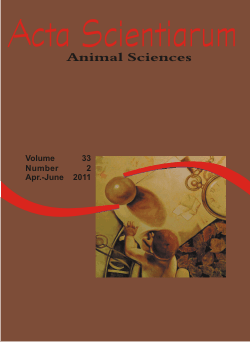<b>Intake and digestibility of diets containing energy sources associated with sunflower meal or urea in feedlot steers</b> - doi: 10.4025/actascianimsci.v33i2.11049
Keywords:
Bovine, co-products, digestion, energy sources, nitrogen sources
Abstract
The aim of this study was to evaluate the intake and total and partial digestibility of diets using corn, soybean hulls and citrus pulp associated with sunflower meal or urea in feedlot steers. Four steers ½ Aberdeen Angus vs. ½ Nellore, fitted with rumen and duodenum cannulas, with 18 months old and 360 kg of initial weight. The diets were composed of two energy sources (corn and citrus pulp) associated with two nitrogen sources (urea and sunflower meal), in a total of four treatments, with forage:concentrate ratio of 40:60. The statistical design was a Latin square with four treatments and four periods of 21 days each. The average daily dry matter intake was influenced (p < 0.05) by the diets, with the highest value was observed in corn and sunflower meal diet. The apparent digestibility of all components, except the crude protein, was higher (p < 0.05) for diets with citrus pulp. There was no effect (p > 0.05) among diets for ruminal and intestinal digestibility. The use of co-products in animal feed did not impair the digestibility of diets and are shown as high potential ingredients for use in beef cattle diets.Downloads
Download data is not yet available.
Published
2011-04-28
How to Cite
Cleef, E. H. C. B. V., Ezequiel, J. M. B., Fontes, N. A., Faturi, C., Oliveira, P. N., & Stiaque, M. G. (2011). <b>Intake and digestibility of diets containing energy sources associated with sunflower meal or urea in feedlot steers</b> - doi: 10.4025/actascianimsci.v33i2.11049. Acta Scientiarum. Animal Sciences, 33(2), 163-168. https://doi.org/10.4025/actascianimsci.v33i2.11049
Issue
Section
Ruminant Nutrition
DECLARATION OF ORIGINALITY AND COPYRIGHTS
- I Declare that current article is original and has not been submitted for publication, in part or in whole, to any other national or international journal.
The copyrights belong exclusively to the authors. Published content is licensed under Creative Commons Attribution 4.0 (CC BY 4.0) guidelines, which allows sharing (copy and distribution of the material in any medium or format) and adaptation (remix, transform, and build upon the material) for any purpose, even commercially, under the terms of attribution.
Read this link for further information on how to use CC BY 4.0 properly.
0.9
2019CiteScore
29th percentile
Powered by 








































